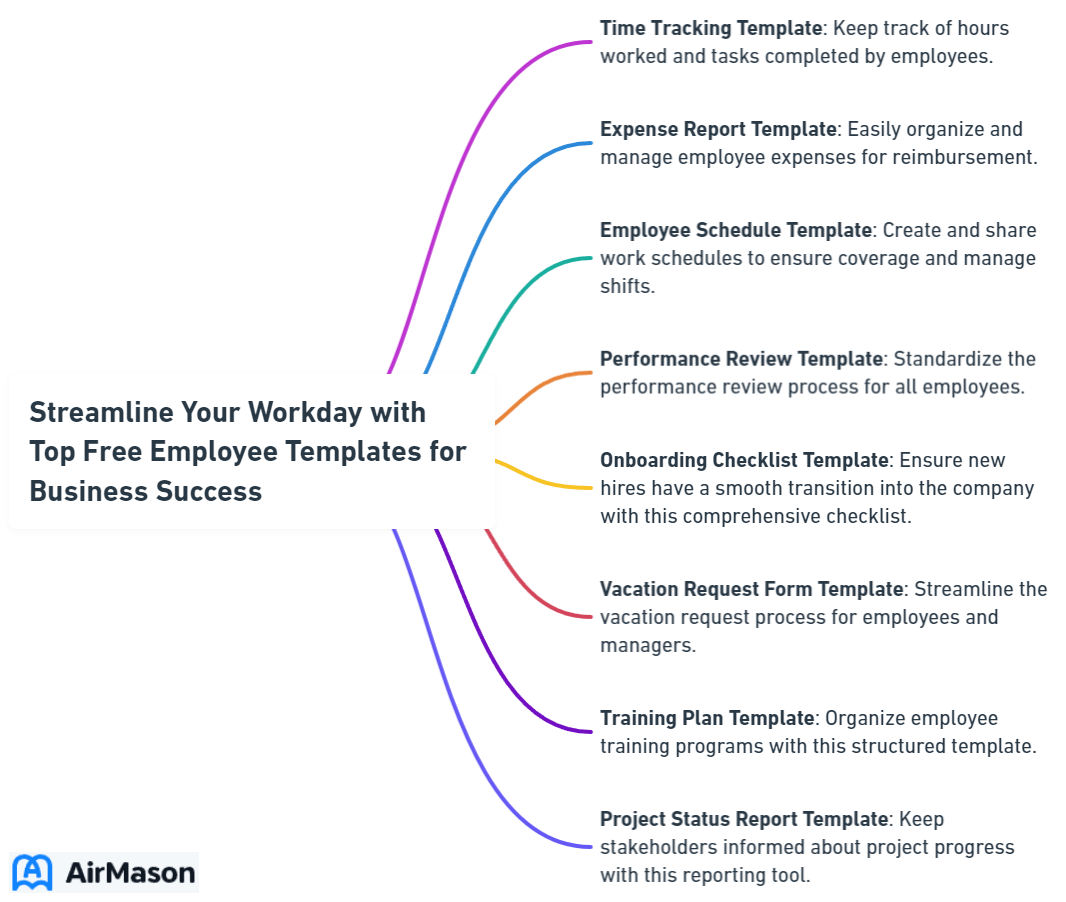
Looking to elevate your HR operations on a budget? Free employee templates are your solution. Enhance your business’s efficiency and ensure your employees are managed effectively with templates that cover everything from onboarding to exit interviews, at no cost. Discover how these versatile tools can help you navigate the complexities of HR management, safeguarding both time and money.
Key Takeaways
- Free employee templates streamline HR and business processes, offering time savings and consistency in company documentation, while onboarding roadmaps and performance evaluation tools enhance the employee journey.
- Employment contracts are critical for defining the relationship between employer and employee, and must include detailed terms, comply with labor laws, and be tailored to reflect diverse roles within the organization.
- Maintaining legal compliance with continually evolving regulations is essential for effective HR management, necessitating regular updates and customization of HR templates and policies.
Employee Handbook Agreement
The Employee Handbook Agreement serves as a foundational document outlining the rights, responsibilities, and expectations of both the employer and the employee within the organization. This agreement represents a mutual understanding between the employer and the employee regarding company policies, procedures, and conduct standards. By signing the Employee Handbook Agreement, employees acknowledge that they have received, read, and understood the contents of the handbook. Additionally, it signifies their commitment to adhering to the guidelines outlined within it throughout their employment tenure. Clear communication and compliance with the provisions laid out in the agreement foster a positive work environment and contribute to the overall success of the organization.
Unlocking Efficiency: The Power of Free Employee Templates

Free employee templates offer a plethora of benefits, including significant time savings, enhanced efficiency, and cost reductions for businesses. These templates revolutionize administrative tasks by fostering consistency across company documentation, thereby promoting a professional, uniform look and feel. The beauty of these templates lies in their versatility. They can be easily customized for specific needs using online form builders and other tools, ensuring seamless integration into regular business processes. Staying current with the latest HR trends is crucial for maintaining updated and relevant templates. This involves routine updates and verifying the credibility of online resources offering these free tools.
From onboarding and scheduling to various HR functions, a wide array of these templates is available, enhancing the accessibility and scope of resources for businesses.
Time Management with Timesheet Forms
In the quest for efficiency, timesheet forms come to the rescue by providing an effective way to track work hours, manage project costs, increase billing accuracy, and improve payroll processing. These forms not only help in better resource allocation and project management, but also promote accurate billing and client invoicing, building trust and credibility with clients. In addition, they facilitate compliance with labor regulations by accurately recording work hours and overtime, which is a significant advantage in an era of stringent labor laws.
Employing timesheet form templates allows employees to submit thorough timesheets for manager review, who in turn has the authority to approve or reject them.

Streamlining Requests with Request Form Templates
Request form templates facilitate the streamlining of HR operations and expedite the approval process for leave requests. By standardizing submissions with clear instructions, these templates lead to more organized and responsive HR operations, capturing essential details for efficient processing. Additionally, the design of these templates is aimed at minimizing errors by ensuring that all necessary information is requested upfront, saving valuable time and reducing the risk of miscommunications.
One example of a specific request form template that has revolutionized managing employee leave efficiently is the ClickUp Time Off Request Template, which centralizes time off requests.
Enhancing Recruitment with Job Application and Interview Templates
The hiring process can be a daunting one, with numerous potential candidates and a variety of job titles. However, the use of job application and interview templates can simplify this process and ensure unbiased evaluations. These templates standardize the process, ensuring that all candidates provide required information in a consistent format.
Moreover, they help maintain a structured approach for interviewing account managers by asking the same critical questions to evaluate candidates equitably and efficiently assess their suitability for the role. Not to mention, a professional and organized recruitment process using templates enhances the employer brand, signaling a well-managed and fair hiring practice.
Crafting the Perfect Employment Contract

An employee contract, also known as an employment contract, is a vital document that details the obligations of both the employer and the employee, including determining the payment method and fulfillment of duties. The aim of such a contract is to clearly define the terms of employment, including payment, thus fostering transparency and reducing potential disputes.
Discussing fundamental terms such as hourly pay, assigned job title, and job responsibilities is a vital step before drafting an employment contract. Following these negotiations, a job offer letter formalizing these terms is issued before the contract is finalized. To formalize the agreement, especially for executive positions, having the contract signed in the presence of a notary public is highly recommended.
After completing the employment contract, it is recommended that both parties have their legal counsels review the document, and then sign the contract if in agreement. Inclusion of non-disclosure and non-compete agreements within an employment contract addresses the confidentiality and competition concerns during and after employment.
How Much Does an Employee Handbook Cost
“How much does an employee handbook cost?” is a common question among employers looking to establish comprehensive guidelines for their workforce. The cost of creating an employee handbook can vary depending on several factors, including the size of the company, the complexity of policies, and whether it’s created in-house or outsourced to professionals. Generally, DIY options might incur minimal expenses, primarily involving time and resources for research and drafting. Conversely, hiring professional HR consultants or legal experts to develop a customized handbook could range from a few hundred to several thousand dollars. Additionally, ongoing updates and revisions may incur additional costs over time
Components of an Employment Contract
An employment contract is more than just a piece of paper; it’s a comprehensive document that should detail the job title, responsibilities, work schedule, and any performance goals expected from the employee. It should also specify the salary or hourly wage, potential bonuses or raises, and commission structures, as well as outline the benefits to ensure employees are adequately rewarded.
Furthermore, termination procedures, including notice periods and grounds for termination, should be outlined to offer protection and understanding of the conditions under which the employment may be ended. The employment contract should be tailored to the job type—full-time, part-time, or freelance—with specific terms and conditions reflecting the role’s requirements.
Adhering to Employment Laws
One misstep in the employment domain can result in significant consequences. Therefore, adherence to federal minimum wage standards and compliance with wage determinations under the Service Contract Act for prevailing wages are critical aspects of employment contracts. For health and welfare fringe benefits, employers can choose to provide these in kind or pay them in cash, according to the nationwide survey rate and up to specific limits regarding hours and annual maximums on each contract. To navigate these complexities, consulting with an employment lawyer or legal advisor is crucial.
Moreover, the employment contract should adhere to all applicable labor laws, such as the Fair Labor Standards Act and ACA, and include notice requirements for termination as mandated by the Employment Standards Act.
Customization Tips for Different Roles
Not all roles are created equal, and neither should their contracts be. Customizing employment contracts helps to identify the specific skills required for different roles and supports HR in making informed staffing decisions.
Organizational Excellence with HR Forms and Documents

Effective HR departments hinge on HR forms and documents. Used to collect, track, and manage employee information and activities, these forms are instrumental in maintaining organizational excellence. HR forms are essential for a variety of tasks, including:
- Onboarding new staff
- Managing time-off requests
- Conducting performance evaluations
- Documenting disciplinary actions
- Requesting employee feedback
- Tracking employee training and development
- Managing benefits enrollment and changes
They facilitate the efficient execution of many human resources responsibilities.
HR forms significantly boost an organization’s efficiency by:
- Streamlining employment processes for HR professionals
- Standardizing employee information collection
- Maintaining accurate records
- Meeting legal requirements
- Preventing the loss of vital information
Essential HR Forms for New Employees
Beyond a warm welcome, the onboarding process for new employees is a critical phase involving the completion of several forms. These forms ensure all necessary personal, tax, and employment details are recorded accurately. New hires are required to fill out:
- An employee personal information form
- Tax withholding forms, such as the W-4
- Confidentiality agreements, such as non-disclosure agreements (NDAs)
- I-9 Employment Eligibility Verification forms
These forms are part of the essential paperwork that confirms an employee’s eligibility to work in the United States and protects company information.
Also, benefits enrollment forms for health insurance, 401(k) plans, and life insurance beneficiary designations are integral to the onboarding process.
Managing Performance with Evaluation Tools
Performance evaluations are a vital process for maintaining high employee productivity and satisfaction. These evaluations facilitate clear communication and set goals for future performance. Employee performance review templates generally include sections for:
- Job knowledge
- Work quality
- Attitude
- Ratings
- Written comments
- Signature fields for accountability.
These templates can be automated and integrated into HR workflows for efficiency, with features like email notifications for form status changes and peer review inclusions in 360-degree feedback forms.
Disciplinary Procedures Documented
Disciplinary action forms are an essential tool for documenting employee misconduct and subsequent corrective measures taken by the organization. These forms provide a record of the incident, the steps taken to address it, and the expectations for future conduct of the employee. Templates for disciplinary action forms can include a checklist of possible violations, details of the incident, statements from both the employee and supervisor, and the disciplinary decision taken.
Disciplinary action forms, such as a sexual harassment complaint form, typically require signatures from the employee acknowledging the issue and from the supervisor or HR representative who administered the action. Free templates for these forms can often be downloaded from HR resources websites, allowing organizations to customize the documents to their specific procedures and policies.
From Hiring to Retiring: Comprehensive HR Templates

HR templates serve as a guiding light throughout an employee’s journey within the company, covering crucial phases including:
- Recruitment
- Onboarding
- Performance Evaluation
- Training
- Offboarding
The ClickUp HR SOP Template is a prime example of a comprehensive tool that guides organizations or teams in completing specific HR processes.
Onboarding Process Roadmaps
The onboarding process is a pivotal phase in an employee’s journey. Onboarding roadmap templates assist in structuring a new employee’s initial 90 days, encompassing:
- Pre-boarding
- Orientation
- Collaboration
- Transition to full autonomy in their role
These roadmaps can also offer a complete lifecycle plan from pre-boarding to retirement for business sales managers and business sales representatives, ensuring consistency in the employee experience through their tenure.
Digital transformation efforts include the development of onboarding roadmaps that digitalize processes and tools, aiming to make the integration of new hires more efficient. Key aspects for effective use of employee onboarding templates include:
- Preparation
- Welcome packages
- Orientation scheduling
- Mentorship programs
- Feedback mechanisms
Career Development and Promotion Forms
Career development is a crucial aspect of employee motivation and retention. Career development plan templates are instrumental in aligning employees’ personal goals with organizational objectives, facilitating both short-term growth and long-term career aspirations. Effective career development plans incorporate various formats such as:
- Lists
- Diagrams
- Tables
- Mind maps
They feature a blend of long and short-term goals, sequences of experiences, and developmental resources such as educational courses and professional networks.
Timely milestones and realistic timeframes in career development plans enhance employee engagement, thereby increasing retention by demonstrating the organization’s commitment to individual career paths. An employee engagement survey can be a valuable tool to measure and improve this engagement.
Offboarding Checklists and Termination Letters
Offboarding, much like onboarding, is a critical phase in an employee’s journey. A termination letter should detail the dismissal reasons, severance pay, and final paycheck date, while being sensitive and legally compliant to minimize the risk of lawsuits. Offboarding checklists ensure a structured process for:
- thanking the departing employee
- knowledge transfer
- asset recovery
- revoking system access
amongst other key steps.
A comprehensive offboarding process includes up to nine steps, crucial for a smooth transition and knowledge retention within the company.
Maximizing HR Efficiency: Advanced Template Strategies

Identifying HR tasks that are repetitive and standardized can guide the selection of templates to boost efficiency. Templates can be selected based on the volume of HR paperwork and the frequency of use for particular forms or documents. For increasing efficiency, HR templates should be compatible with digital signature software to eliminate the need for manual signing.
Automation tools can streamline the completion and submission of repeated HR-related tasks, like leave requests and expense claims. Using HR platforms that automate the flow of information between interconnected templates can reduce errors and save time.
Selecting the Right Template for Your Needs
Choosing the right HR manual template requires careful consideration of your company size, industry, and specific HR needs. The selection of the right format for an HR manual template, such as Microsoft Word, Apple Pages, or PDF, depends on how the information is communicated to employees and ensuring easy template customization for logical employee navigation.
HR templates designed for data management and featuring data lookups facilitate the maintenance and update of employee information in the HR department, simplifying data extraction for reporting and decision-making processes.
Customization Best Practices
Customizing templates with company-specific details such as logos and branding can reinforce the employer brand and convey company values. Templates should feature clear headers and accessible design on various devices to enhance the user experience and improve engagement.
Templates must use consistent field names and may include encryption or anonymization to manage sensitive data securely and maintain privacy. Maintain control over form submissions and updates, ensuring that any change management like follow-up reminders or edits to field names does not compromise data integrity.
Integration and Automation Techniques
Integrating HR templates into existing systems can be facilitated by using HR software that supports template import and customization. Careful consideration of the template’s properties and their compatibility with the technology in use is necessary for successful integration of HR form templates into an organization’s systems.
The use of APIs can streamline the integration of HR templates into broader organizational systems by facilitating more efficient data handling and analysis. Setting up automation techniques like follow-up reminders and notifications for form submissions can streamline HR processes, ensuring timely and efficient actions are taken.
Navigating Legal Compliance and Company Policy
Maintaining relevant and effective HR templates and forms necessitates staying informed about HR trends, legal changes, and company policy updates. Regularly reviewing and updating templates ensures that organizations operate under the latest legal standards and nurture a fair and transparent work environment.
Legal Requirements and Industry Compliance
Given the ever-changing landscape of employment laws and regulations, organizations must keep up-to-date and ensure their HR templates reflect the latest legal standards. This includes updates to the National Living Wage, new rights granted by the Carer’s Leave Regulations 2024, and changes to the Workers (Predictable Terms and Conditions) Act 2023, amongst others.
The introduction of new regulations like the Employment Rights (Amendment, Revocation and Transitional Provisions) Regulations 2023, which affect holiday accrual and pay, highlight the constant evolution of employment laws and the ongoing necessity to review and update HR templates for legal compliance.
Aligning Templates with Company Policies
Regular updates to the HR manual should be scheduled, with at least annual reviews to ensure compliance with the latest laws, regulations, and company policies. Updating policies and procedures in the HR manual is vital to ensure compliance and effectiveness, ideally involving a team from HR, legal, and other departments. Company policies on topics such as:
- vacations
- time tracking methods
- social media guidelines
- complaint filing procedures
- anti-discrimination and harassment policies
- sick leave
- dress codes
- pay schedules
should be clearly documented in organizational policies or employee handbooks.
Effective communication with employees about ethical behavior and best practices is essential for compliance, requiring clear and accessible messaging for all organization members.
Summary
In conclusion, free employee templates are an invaluable asset to any organization, offering a myriad of benefits including enhanced efficiency, consistency, and professionalism across various HR functions. Whether it’s crafting the perfect employment contract, managing performance with evaluation tools, or navigating legal compliance and company policy, these templates provide a structured, streamlined, and efficient approach to HR processes. By understanding how to select, customize, and integrate these templates into existing systems, organizations can truly unlock their HR potential.
Frequently Asked Questions
What are the benefits of using free employee templates?
Using free employee templates can save time, enhance efficiency, boost professionalism, and cut costs for businesses, while promoting consistency and uniformity across company documentation. These benefits can revolutionize administrative tasks.
How can timesheet forms improve payroll processing?
Using timesheet forms can improve payroll processing by providing an efficient way to track work hours, manage project costs, and increase billing accuracy, ultimately leading to improved payroll processing. They also contribute to accurate billing and client invoicing, fostering trust and credibility with clients.
What are the essential components of an employment contract?
The essential components of an employment contract include job title, responsibilities, work schedule, performance goals, salary, bonuses, benefits, and commission structures. Make sure these are clearly outlined in the contract to avoid any misunderstandings.
How can HR templates maximize efficiency?
Using HR templates for repetitive and standardized tasks can increase efficiency by streamlining paperwork and digital signature compatibility eliminates manual signing, saving time and effort.
What are some of the legal requirements for HR templates?
When creating HR templates, it is crucial to ensure they incorporate the latest legal standards and updates, such as those related to the National Living Wage, Carer’s Leave Regulations, and Workers (Predictable Terms and Conditions) Act.
Important Disclaimer:
Please be aware that the content on this page has been generated by using artificial intelligence language models and may contain errors, inconsistencies, or outdated information. It is provided as-is without any warranties or guarantees of accuracy.
We strongly recommend using this content as a starting point for further research. We disclaim any liability for damages or losses resulting from the use or reliance on this content.